人教版新目标版七年级英语上册Starter教案新版
最新人教新目标七年级starter unit1-unit3教案

Unit 1 Good morning!Mainly prepared by: Shen Lei Date: Aug.29th-30thI. Teaching Contents: Unit 1 Good morning!II: Analysis of the Teaching Material1.Status and FunctionThe topic of this unit is about meeting friends, and the students will learn to practice some English names, common English greetings and the letters Aa-Hh. 2.Teaching Aims and Demands(1)Knowledge Objectsa.To master the letters A-H.b.To master the common English greetings.(2)Ability ObjectsTo improve students’ ability of listening, speaking and writing.3.Teaching Difficult PointsTo master the key vocabulary and the target language presented in this unit.4.Teaching focuses(1)To learn how to read and write the letters Aa-Hh.(2)To learn how to greet in English.(3)To do listening exercises.III. Language FunctionTalk about how to greet people.IV. Target LanguageGood morning, good afternoon, good evening, hi, helloHow are you? I’m fine, thanks.Letters Aa-Hh.V. V ocabularyAa, Bb, Cc, Dd, Ee, Ff, Gg, Hhgood, morning, afternoon, evening, hi, hello, fine, OK, thanksVI. Teaching TimeFive periodsPOSTSCRIPT:(课后记)Unit 2 What’s this in English?Mainly prepared by: Shen Lei Date: Sep 6th-8thI. Teaching Contents: Unit 2 What’s this in English?II: Analysis of the Teaching Material1.Status and FunctionIn this unit students learn to ask how to say and spell words in English and the letters Ii-Rr. The topic of this unit is about things around people, and the students can learn how to identify things.Teaching Aims and Demandsa)Knowledge Objects(1) To master the letters I-R;(2) To master how to identify things and spell words;(3) To learn “what” question.b)Ability ObjectsTo improve students’ ability of listening, speaking and writing.2.Teaching Difficult Points(1) To master the key vocabulary and the target language presented in this unit;(2) Pronunciation of letters A, E, I, O;(3) Listening and speaking practice.3.Teaching focuses(1)To learn how to read and write the letters Ii-Rr;(2)To learn “what” question;(3)To learn to ask how to say and spell words.III. Language FunctionTalk about how to identify things and spell words IV. Target LanguageWhat’s this in English?It’s a key.Spell it, please.K-E-Y.V. V ocabularyIi, Jj, Kk, Ll, Mm, Nn, Oo, Pp, Qq, Rrjacket, key, map, orange, pen, quilt, ruler, spell VI. Teaching TimeFive periodsPOSTSCRIPT:(课后记)单元教学测评一、将26个字母按发音分类(写出与所给字母含有相同音素的其他字母)Aa ____________________________________________________________________ Ee ____________________________________________________________________ Ii _____________________________________________________________________ Oo ___________________________________________________________________Uu ____________________________________________________________________Ff ____________________________________________________________________Rr ____________________________________________________________________ 二、从A、B、C、D中选出含有相同音素的选项号中的要求写出以下单词的适当形式( )1.A.a f B.b p C.d j D.i r( )2.A.b i B.d r C.g p D.j p( )3.A.h l B.e u C.h m D.n x( )4.A.m w B.s r C.c f D.z l( )5.A.h z B.s v C.v h D.f s三、按括号内所给要求写出适当形式1.White ____________ (反义词) 2. color(n.)_________ (动词)3.boy ____________ (反义词) 4.Mr ___________(对应词)5.father __________ (对应词)四、单项选择( )1.It’s ___________ black.It’s ________ black ruler.A. /; / B.a;/C./;a D.a;a( )2. ---________ is that quilt? —It’s black.A. Which color B.How color C.What color D.What’s color( )3.一Who is that girl? 一The ______ in the blue jacket?一Yes.-- It’s Zhang Lei.A.one B.an C.a D./( )4.What’s that _____ English?A.at B.to C.in D.on( )5.一What color is her jacket? 一It’s _______.A.an orange B.orange C.the orange D.a orange五、句子配对A B1.What’s this in English? A.The one in blue.2.Is this a book? B.He’s my father.3.Who’s that man? C.It’s orange.4.What color is that orange? D.Yes.it is.5.How are you? E.It’s a map.6.Which boy is your brother? F.No, it’s yellow.7.What is this? G.It’s an orange.8.Is that jacket black? H.Fine,thank you.六、改错(下列各句均有一处错误,找出并改正)1.What color is that ruler? It's a red.A B C D2.This is her blue color bike.A B C D3.M r. Green is in the China now.A B C D4.Can you spell a pen, please?A B C D5.What’s color is this?A B C D七、阅读短文,判断正误:正确的写“T”错误的写“F”Jane White is an American girl.She is a student.She is fifteen.Her father is Mr.White.Her mother is Mrs.White.Bob is her brother.He is a student.t∞.He is in a black jacket.Jane is in a red jacket.She is a nice girl.( )1.Jane White is English.( )2.She is a student.( )3.Mr. White is her mother.( )4.Jane is fourteen.( )5.Jane is Mrs. White’s daughter.( )6.Bob is Jane’s brother.( )7. Jane is Bob’s brother.( )8. Bob is a teacher.( )9. Jane is in red and Bob is in black.( )10. Jane is a nice girl.参考答案一、AHJK EBCDGPVZ IY O UW FLMNSXZ R二、1-5 BCDDD三、1. black 2. color 3. girl 4. Mrs 5. mother /mom /mum四、1-5 CCACB五、1-8 GDBCHAEF六、1. D red 2. D 去掉3. C China 4. C pen 5. A What七、1-5 FTFFT 6-10 TFFTT。
新版教材新目标七年级英语上册starter教案设计
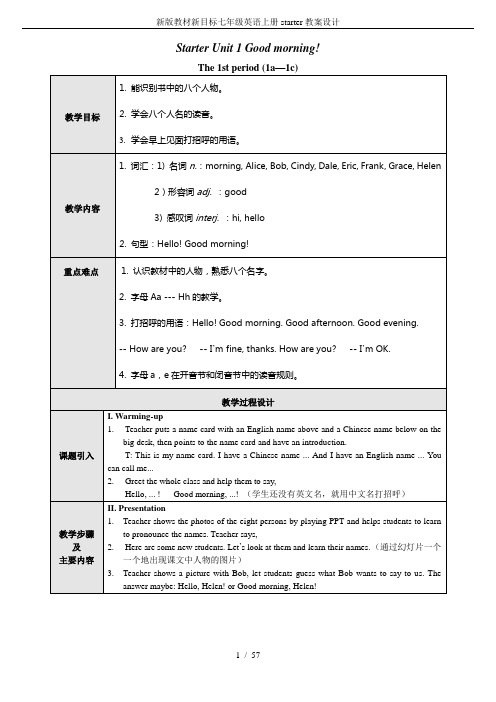
Starter Unit 1 Good morning!ndrdIV. Practice.1.Work on 4a(1)T: Now open your books and turn to Page 4. Write down the children’s names below their faces.(2)T: Write the names in the alphabetical order in the list.(3)Check their answers. (提醒学生注意名字的第一个字母应大写。
)2.Work on 4b(1)Play the recording for the first time. Students only listen.(2)Play the recording for the second time. Students listen and repeat.(3)Ask some students to read the letters and words.3.Work on 4c(1)Ask Students to read aloud the words on the left. Make sure they know the distinction between different pronunciations of the same letter.(2)Ask Students to try to read the new words on the right. Teacher moves around the classroom and helps students if necessary.(3)Check their pronunciations.(4)Get students to turn to Page 71. Look at the words in Starter Unit 1 Good morning. Listen and read. Pay attention to the four vowel sounds. /ei/ // /i:/ /e/4.Work on 4d(1)Play the song for the students to listen.(2)Students listen and sing the song after the recording.(3)Students sing the song together.(4)Boys try, then girls try.Starter Unit 2 What’s this in English?Starter Unit 3 What color is it?ndUnit 1 My name’s Gina.Unit2 This is my sister.Unit 3 Is this your pencil?thUnit 4 Where’s my schoolbag?thUnit5 Do you have a soccer ball?thUnit6 Do you like bananas?thUnit7 How much are these socks?thUnit8 When is your birthday?th。
七年级英语上册(人教新目标GoForIt!)StarterUnit2第1课时(1a2e)优秀教学案例

3.教师总结:本节课我们将学习日常问候和介绍,以更好地与不同国家的人交流。
(二)讲授新知
1.教师通过多媒体展示本节课所学的问候语和介绍语,如Hello!/Hi!/Good morning!/Good afternoon!/Good evening!/How are you?等,并引导学生跟读。
3.运用交际法,鼓励学生积极参与课堂互动,提高学生的口语表达能力和团队协作能力。
4.利用多媒体教学资源,如图片、视频等,为学生提供丰富的视觉和听觉感受,帮助学生更好地理解和掌握课程内容。
(三)情感态度与价值观
1.培养学生对英语学习的兴趣,树立自信心,养成积极向上的学习态度。
2.培养学生具备良好的合作意识,学会尊重他人,培养团队精神。
3.小组合作学习的深入推行:教师合理分配学习小组,鼓励小组成员共同探讨、分工合作,完成任务。这种方法培养了学生的团队精神和沟通能力,使他们在合作中学习,提高了学习效果。
4.教学评价的全面开展:教师引导学生对自己的学习过程进行反思,总结自己的优点和不足,调整学习策略。同时,开展同伴评价,让学生互相观摩、借鉴,共同提高。这种评价方法有助于学生全面认识自己的学习情况,提高了他们的自我管理和自我提高能力。
1.情境教学法的创新应用:教师通过多媒体展示了不同国家的问候语和介绍方式,引导学生思考和讨论,激发了学生的学习兴趣,并成功吸引了他们的注意力。这种方法不仅有助于学生理解文化差异,还使他们在真实情境中学习和实践,提高了他们的语言运用能力。
2.任务型教学法的有效实施:教师设计了具有挑战性和实际意义的任务,让学生在完成任务的过程中,巩固所学知识,提高交际能力。这种方法使学生在实践中学习,增强了他们的自主学习能力和解决问题的能力。
人教新目标七年级英语上册StarterUnit2教学设计

2.英语基础:学生在小学阶段已经接触过英语,具备一定的英语基础,但发音、词汇和语法等方面的掌握程度参差不齐,需要教师在教学中关注个体差异,因材施教。
3.学习动机:学生对英语学习充满热情,希望在实际生活中运用英语进行交流,提高自己的综合素质。教师应充分利用这一特点,激发学生的学习积极性,提高课堂参与度。
(2)学生用英语编写一段关于日常问候的对话,可以是与同学、老师或家人之间的交流,下节课进行展示。
2.写作作业:
(1)完成课本练习册中与本节课相关的练习题,巩固核心词汇和问候语。
(2)根据本节课学到的问候语,写一篇小短文,描述一天中不同时间与不同人的问候场景。
3.听力作业:
(1)学生课后听英语歌曲《Hello Song》,并尝试跟唱,提高英语听力水平。
在整个教学过程中,教师应关注学生的个体差异,充分调动学生的积极性,鼓励他们积极参与课堂活动。同时,教师要注意营造轻松愉快的学习氛围,关注学生的情感需求,使他们在愉快的氛围中学习英语。
五、作业布置
针对本节课的教学内容,特此布置以下作业,以巩固所学知识,提高学生的英语运用能力:
1.口语作业:
(1)要求学生课后与家人、朋友用英语进行问候,录制成小视频,下节课分享。
2.教学活动设计:将学生分成若干小组,每组选择一个场景进行讨论,准备一段对话。然后,每组进行展示,其他同学观摩并给予评价。
3.教学目的:通过小组讨论和角色扮演,培养学生的合作意识,提高他们的语言运用能力。
(四)课堂练习
1.教学内容:针对本节课的核心词汇和问候语,设计练习题,巩固所学知识。
Starter Unit1教案2024-2025学年新人教版七年级上册

新人教版英语七年级上册Starter Unit 1Hello!单元教材分析本单元教材以“打招呼”为中心话题,围绕着“怎样和人打招呼?”及“如何开始一段对话?”进行学习和运用相关知识。
Section A主要学习和人打招呼的常用表达及生活中常用的缩略形式,并复习26个英语字母的读音和书写。
要掌握的重点句型有:Hello!/Hi!/Good morning!/What's your name?/Nice to meet you.等。
Section B的重点是要求学生读懂两段小对话,完成所安排的读写任务,教师在教学中应合理利用课本上的知识进行教学。
这个单元分为两个课时,第一课时Section A和第二课时Section B。
单元课程标准要求1.词汇:unit, greet,spell, start, conversation,bell, hello,how, do , you , people , good ,morning, class , my, name , over, goodbye , what,your, what, where, here, are,nice, meet, may, have, can ,call, me, too, fine, thanks , great, that, the, let,us, go,bye, time, for,good morning, good afternoon, good evening, your name,myname,thank you ,etc .2.句型:Good morning/afternoon/evening! What’s your name?How do you spell your name?How are you?I am fine,thanks./I am OK.Nice to meet you. Nice to meet you ,too.It’s time for class.3.认识新教材设计板块,创编一段对话,在不同场合能和新认识的朋友、老师打招呼,积极交流,意识到在人际交往中主动打招呼、礼貌展开对话的重要性4.能正确认读、规范书写26个英文字母,理解常见字母缩略语和字母排序在日常生活与学习中的常见运用,学会区分字母的音。
人教版2024七年级上册英语Starter Unit 1 Lesson 2 教案
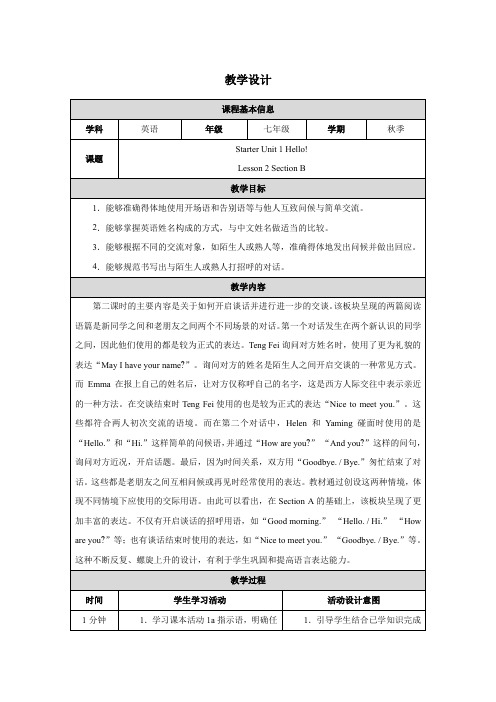
5分钟
10.游戏:学生阅读第一组句子,按照顺序将句子排序使其成为一段完整的对话。
11.游戏:学生阅读第二组句子,按照顺序将句子排序使其成为一段完整的对话。
10~11.依托游戏引导学生进一步感知两段对话的开启到结束的过程,分别掌握与陌生人和熟人之间如何开展对话。通过游戏过程了解学生对于所学知识的掌握情况。
教学过程
时间
学生学习活动
活动设计意图
1分钟
1.学习课本活动1a指示语,明确任务内容。
在活动1a中勾出用于开启谈话的表达方式。
1.引导学生结合已学知识完成练习,初步小结见面打招呼的常用表达。
1分钟
2.学生观察活动1b中对话1的图片,回答问题。
2.引导学生观察对话的主题图,预测对话内容,培养学生通过图片进行预测的阅读策略。
6.引导学生观察对话的主题图,预测对话内容,巩固学生通过图片进行预测的阅读策略。
6分钟
7.学生阅读对话2,画出对话中的问候语。
8.学生进行小组活动,再次阅读对话2,用对话中的句子填写表格。
9.学生两人一组朗读对话2。
7.引导学生通过阅读掌握与问候相关的表达方式。
8.引导学生通过完成图表分析对话结构。
10分钟
15.学生两人一组根据图表提示完成对话的角色扮演。
15.依托可视化的图表帮助学生通过角色扮演的方式将所学知识内化,并加以运用。
作业
找出更多世界上打招呼和开启谈话的方式。
开拓学生视野,激发学生的学习兴趣。
6分钟
3.学生阅读对话1,画出对话中的问候语。
4.学生进行小组活动,再次阅读对话1,用对话中的句子填写表格。
5.学生两人一组朗读对话1。
七级英语上册《starterUnitteachingplan》教案人教新目标版
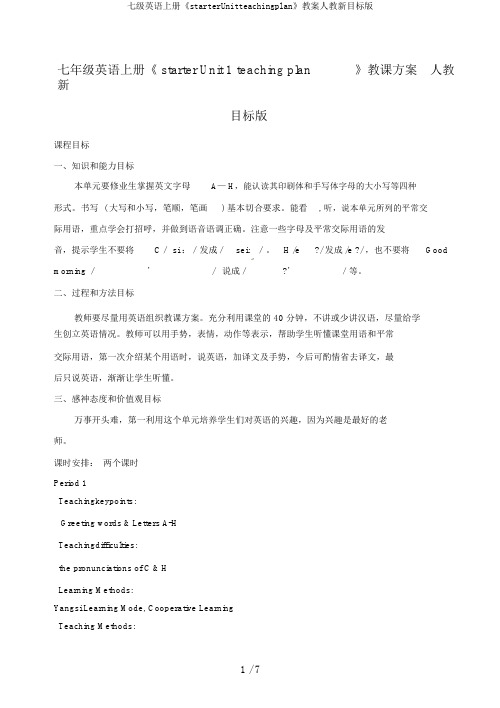
七年级英语上册《 starter Unit 1 teaching plan》教课方案人教新目标版课程目标一、知识和能力目标本单元要修业生掌握英文字母A— H,能认读其印刷体和手写体字母的大小写等四种形式。
书写 ( 大写和小写,笔顺,笔画) 基本切合要求。
能看, 听,说本单元所列的平常交际用语,重点学会打招呼,并做到语音语调正确。
注意一些字母及平常交际用语的发音,提示学生不要将C/ si :/发成/sei:/。
H /e?/ 发成 /e ?/ ,也不要将Good morning /'/说成/?'/等。
二、过程和方法目标教师要尽量用英语组织教课方案。
充分利用课堂的 40 分钟,不讲或少讲汉语,尽量给学生创立英语情况。
教师可以用手势,表情,动作等表示,帮助学生听懂课堂用语和平常交际用语,第一次介绍某个用语时,说英语,加译文及手势,今后可酌情省去译文,最后只说英语,渐渐让学生听懂。
三、感神态度和价值观目标万事开头难,第一利用这个单元培养学生们对英语的兴趣,因为兴趣是最好的老师。
课时安排:两个课时Period 1Teachingkeypoints:Greeting words & Letters A-HTeachingdifficulties:the pronunciations of C & HLearning Methods:Yangsi Learning Mode, Cooperative LearningTeaching Methods:1 / 7Yangsi Teaching Mode, Situational Approach, Task-based Teaching Approach, theteaching mode of Two-way InteractionTeachingprocedures:Step 1IntroductionBegin by greeting the class with a smile and good morning!Now intr oduce the words “teacher ”and“class ”by using gestures Repeat this several times and have the class repeat after you Students Can answeras a whole group As rows and a s individuals Repeat“I am your teacher andyou are the class”several timesNow introduce the class to the instructions Class please sit down and class please stand up by using actions and gestures They can practice this several timesStep 2Lead — inYou may want t0 leave the class again to introduce the usual Good morningroutine Say Good morning class Help students respond with Good morning Point to yourself and say I ’m Miss Mr Have them repeat Explain the terms Miss and Mr in ChineseRepeat this a few times with rows and individuals or try a“back -chain ”dr illMiss Mr(Ss repeat)Mor ning Miss M r(S s repeat)Good morning Miss Mr(Ss repeat)Step 3PracticeSay Stand up please!(Ss stand up)Leave the classroom return and say Good morning class!Help the students respond withGood morning Miss Mr Say Sit down please Now let ’s start the lesson2 / 7Step 4Presentation and activityNow point to yourself and say My name is Miss Mr.I am your teacher Find a student you know and say your name is(Beth)Then ask What is your name?Help them respond with My name is.When the student answers, respond with Hel lo Niceto meet you!Repeat thi s activity several times first withstudents you know and then with others Help them to respond with Nice tomeet you too Explain the Wo rd “too ’’ in ChineseStep 5PracticeGet the students to practice the f0llowing d ialogue in pairsS1Good morningS2Good morning I ’m(Ben) What’s your name?Sl My name is(Dale)Nice to meet you!S2 Nice to meet you tooCall out sev eral pairsof students to give their performance Praise their efforts as much as possible Help the slower students with patienceStep 6PresentationDo activity1a Look at the picture Find the small letters for these big lettersFirst present letters a-h and get the students to repeat these letters Call the students toattention the letter C si not sei H /e ?/ not /e?/Step 7Listening and writingGet the students to listen to the tape and finish the task list on the book Make sure all the students know what they should doHave the students watch the teacher writing the l etters on the blackboard,then ask them to follow the teacher and write down these letters on their exercise—books Let the students knowthe diffences between the big lettersand the small letters3 / 7Step 8 : Games timeLet the students do some letters games to enjoy your lesson,the following is theinstruction.抢读字母游戏:教师将全班分成若干小组,尔后逐个出示字母卡片,学生们举手抢答。
七年级英语上册(人教新目标GoForIt!)StarterUnit1第1课时(1a2e)优秀教学案例

1.情景创设:本案例中,通过播放英文歌曲和展示图片等方式,营造了轻松愉快的学习氛围,激发了学生的学习兴趣和积极性。这种情境创设的方式能够使学生更自然地融入到英语学习中,提高了学生的学习效果。
2.问题导向:在教学过程中,我提出了引导性问题,激发了学生的思考和探究欲望。通过问题解决和反思性问题,学生能够更好地理解和运用所学知识,培养了学生的思维能力和解决问题的能力。
5.教学内容与过程:在教学内容的设计上,我结合了学生的实际情况和学科知识,进行了详细的规划和安排。通过导入新课、讲授新知、学生小组讨论、总结归纳和作业小结等环节,学生能够系统地学习和掌握本节课的内容,提高了学生的学习效果和综合能力。
这些亮点都是本案例中突出的一些特点和优势,它们相互交织,共同构成了一个生动、有趣、有效的英语教学课堂。通过这些亮点,学生能够在轻松愉快的氛围中学习英语,提高自己的语言能力和综合素质。
3.针对本节课的学习内容,我会设计一份课堂小测,让学生在课后巩固所学知识。
(五)作业小结
1.在下课前,我会布置一份与本节课内容相关的作业,如让学生写一篇关于自己和他人的简短介绍,培养学生的写作能力。
2.我会提醒学生在完成作业时注意书写规范和语法准确性,并鼓励他们积极向家长展示自己的学习成果。
3.最后,我会告诉学生下节课的学习内容,让他们提前做好准备,为下一节课的学习打下基础。
3.针对课文中的重点词汇和短语,我会设计一些有趣的游戏和活动,如“单词接龙”,让学生在实践中巩固记忆。
(三)学生小组讨论
1.为了让学生更好地运用所学知识,我会设计一个小组讨论活动。例如,让学生四人一组,用目标句型进行自我介绍,然后互相询问组员的信息。
2.在讨论过程中,我会鼓励学生用英语进行交流,培养他们的口语表达能力和团队协作能力。
七年级英语上册《Starter Unit1 Good morning!》全单元教案 (新版)人教新目标版

Go for it! Book I Starter Unit 1 Good morning !单元目标与要求1.学习Aa --- Hh八个字母。
2.学习八个人名。
Alice, Bob, Cindy, Dale, Eric, Frank, Grace, Helen3.学习打招呼的用语:Hello!/ Good morning!/ Good afternoon!/ Good evening!4.学会问候熟识的朋友和应答:-- How are you?-- I’m fine, thanks. How are you?-- I’m OK.单元课时安排The 1st period:Section A 1a, 1b, 2a, The 2nd period:Section A 1a, 2b, 2c, 2d 3, 4aThe 3rd period:Section A 4b, 4c, Section B 1, 2a, 2bThe 4th period: Section B 3a, 3b, 4, 5The 5th period : SelfCheck and Just for Fun The first periodTeaching Contents and Analysis(教学内容与分析)Teaching materials(教学内容):Section A 1a, 1b, 2a,Teaching aims (教学目标)1.识别和掌握八个人名。
2.学会早上见面打招呼的用语。
3.正确认读Aa-Hh八个字母。
language points(语言点)1.词汇:Alice, Bob, Cindy, Dale, Eric, Frank, Grace, Helen2.句型:Hello! Good morning!Analysis of key items and difficulties of teaching(教学重点、难点分析):1、Important Points(重点): A--H八个字母教学,能认读,会书写。
人教新目标英语七年级上册Starter Unit-1全单元教案

人教新目标英语七年级上册Starter Unit 1 Good morning!一、课程目标1、知识和能力目标:a)本单元要求学生掌握英文字母A—H,能认读这八个字母的大小写形式;b)书写(大写和小写,笔顺,笔画)基本合乎要求;c)能看,听,说本单元所列的日常交际用语,重点学会打招呼,并做到语音语调正确;d)注意一些字母及日常交际用语的发音,提醒学生不要将C/si:/发成/sei:/;H /eiʧ/发成/eʧ/等。
2、过程和方法目标:教师要尽量用英语组织教学。
充分利用课堂的45分钟,少讲汉语,尽量给学生创造英语情景。
教师可以用手势,表情,动作等示意,帮助学生听懂课堂用语和日常交际用语,第一次介绍某个用语时,说英语,加译文及手势,以后可酌情省去译文,最后只说英语,逐步让学生听懂。
3、情感态度和价值观目标:万事开头难,首先利用这个单元培养学生们对英语的兴趣,因为兴趣是最好的老师。
二、重点、难点a)听说读写字母A-Hb)学会如何与人打招呼,并识记Good morning、Good afternoon、Good evening、Good night等句子。
三、学情分析由于我校是一个农村大校,农村英语教师缺乏,小学阶段的大部分英语课程都是自习或者非专业老师上课,造成学生英语基础普遍薄弱,学习兴趣不高。
但是七年级学生刚由小学升入初中,思想比较单纯,听话,故可塑性很高。
针对此问题,我会着眼于学生兴趣,放慢学习速度,从ABC字母重新带领学生进入英语学习世界。
本单元将按以下四个课时进行授课:Period 1Step 1:IntroductionBegin by greeting the class with a smile and good morning!Now,introduce the words “teacher” and “class”.by using gestures.Repeatthis several times and have the class repeat after you.Students can answer as awhole group.As rows and as individuals.Repeat “I am your teacher and youa re the class” several times.Now,introduce the class to the instructions:Class,please sit down and class,please stand up by using actions and gestures.They can practice this severaltimes.Step 2:Lead—inYou may want to leave the class again to introduce the usual Good morningroutine.Say Good morning class.Help students respond with Goodmorning.Point to yourself and say I’m Ms.…Have them repeat.Repeat this a few times with rows and individuals or try a “back-chain” drill:Miss,Mr.… (Ss repeat)Morning,Miss/M r.… (S s repeat)Good morning,Miss,Mr.… (Ss repeat)Step 3:PracticeSay:Stand up,please! (Ss stand up)Leave the classroom,return and say Good morning,class! Help the studentsrespond with Good morning,Miss/,Mr.…Say Sit down,please.Now let’sstart the lesson.Step 4:Presentation and activityNow point to yourself and say My name is Miss/Mr. … I am your teacher.Find a student you know and say your name is…(Sarah).Then ask What isyour name? Help them respond with My name is…. When the studentanswers, respond with Hel lo…Nice to meet you! Repeat this activity severaltimes,first with students you know and then with others.Help them torespond with Nice to meet you,too.Explain the Word “too’’ in Chinese.Step 5:PracticeGet the students to practice the following dialogue in pairs.S1:Good morning.S2:Good morning.I’m (Sarah).What’s your name?Sl:My name is (Mary).Nice to meet you!S2:Nice to meet you.too.Call out several pairs of students to give their performance.Praise their efforts as much as possible.Help the slower students with patience.Step 6:PresentationDo activity 1a:Look at the picture.Find the small letters for these big letters.First present letters a-h,and get the students to repeat these letters.Call the students to attention the letter C/si:/not/sei:/.H /eiʧ/ not /eʧ/ Step 7:Listening and writingGet the students to listen to the tape and finish the task list on the book.Makesure all the students know what they should do.Have the students watch the teacher writing the letters on the blackboard, thenask them to follow the teacher and write down these letters on theirexercise—books.Let the students know the differences between the big lettersand the small letters.Step 8:Games timeLet the students do some letters games to enjoy your lesson,the following isthe instruction.抢读字母游戏:教师将全班分成若干小组,然后逐个出示字母卡片,学生们举手抢答。
人教版七年级英语上StarterUnit1(3a-4d)教案

(1)T: Now open your books and turn to Page 4. Write down the children ' s names below their faces.
(2)T: Write thenamesin the alphabetical order in the list. (3) Check their answers.
到Hh,注思
用游戏比赛
(4) Students write down the letters from Aa to Hh by themselves. Ask two students to write on the board.
他们的正确
书写。
的方式,复 习字母,树 立学生的竞
教学过程
学生活动
设计意图
学习新单
词,弄清楚
morning, afternoon
和evening
的区别。
仔细听材
料,完成3a。
两人一组,
练习对话。
s
听录音,学 习新的句
型。
先练习书上 的对话。
然后为自己
氏-个英文 名字,用这
个名子练
争意识。
用钟表教学 这三个单 词,比较直 观。
复习单词, 并完成听力 练习。
练习使用Good afternoon和Good evening表 示问候。
素,并能读
出新单词。
class.
A: Hi, Helen! How are you? B: Hi, Eric! I' m
用一首歌曲
fine, thanks.
听歌并学
复习这节课
习。
人教版七年级英语上册 Starter Unit 1 Section B 2a-2e 教学设计
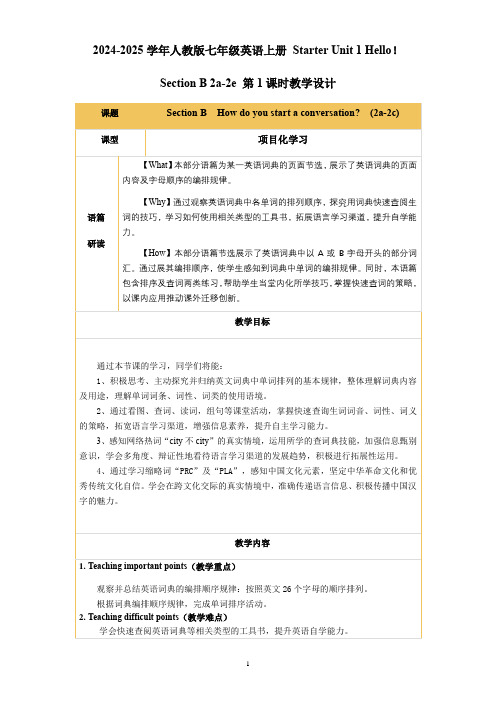
2024-2025学年人教版七年级英语上册Starter Unit 1 Hello!Section B 2a-2e 第1课时教学设计课题Section B How do you start a conversation? (2a-2c)课型项目化学习语篇研读【What】本部分语篇为某一英语词典的页面节选,展示了英语词典的页面内容及字母顺序的编排规律。
【Why】通过观察英语词典中各单词的排列顺序,探究用词典快速查阅生词的技巧,学习如何使用相关类型的工具书,拓展语言学习渠道,提升自学能力。
【How】本部分语篇节选展示了英语词典中以A或B字母开头的部分词汇。
通过展其编排顺序,使学生感知到词典中单词的编排规律。
同时,本语篇包含排序及查词两类练习,帮助学生当堂内化所学技巧,掌握快速查词的策略,以课内应用推动课外迁移创新。
教学目标通过本节课的学习,同学们将能:1、积极思考、主动探究并归纳英文词典中单词排列的基本规律,整体理解词典内容及用途,理解单词词条、词性、词类的使用语境。
2、通过看图、查词、读词,组句等课堂活动,掌握快速查询生词词音、词性、词义的策略,拓宽语言学习渠道,增强信息素养,提升自主学习能力。
3、感知网络热词“city不city”的真实情境,运用所学的查词典技能,加强信息甄别意识,学会多角度、辩证性地看待语言学习渠道的发展趋势,积极进行拓展性运用。
4、通过学习缩略词“PRC”及“PLA”,感知中国文化元素,坚定中华革命文化和优秀传统文化自信。
学会在跨文化交际的真实情境中,准确传递语言信息、积极传播中国汉字的魅力。
教学内容1.Teaching important points(教学重点)观察并总结英语词典的编排顺序规律:按照英文26个字母的顺序排列。
根据词典编排顺序规律,完成单词排序活动。
2.Teaching difficult points(教学难点)学会快速查阅英语词典等相关类型的工具书,提升英语自学能力。
新目标七年级上册Starter_Unit1全英文教案

Starter Unit 1 Good morning!一、Teaching Content:Section A二、Analysis of teaching material and learnersThe main task for students for the whole unit is to learn to use English letters and know some English names and how to use simple words to greet people.For seven grade students,greeting people is a interesting topic,and it's relate to their life and they have the ability to learn new words and sentences.三、Teaching objectives1. Knowledge Objects(1) V ocabulary:8 Letters: Aa---HhEnglish names: Alice, Bob, Cindy, Dale, Eric, Frank, Grace, Helen(2) Sentence:Hi!/Hello!/ Good morning!/ Good afternoon!/ Good evening!2. Skills Objects(1) learn to how to use 8 English letters(2) learn to greet people in different time3. Affect ObjectsHelp student to develop the interest of learning English and good habit to be polite to others,and learn to work in groups as well as cooperate with others and enjoy join the activities in class四、Teaching focus and difficulties1. Teaching focus(1). Be able to listen、speak、read and write 8 letters(2). Be able to learn how to use the simple sentences to greet people in the daily life:--Good morning, Helen!--Hi, Bob!--Hello, Frank! Hello, Eric!--Good morning, Dale!2. Teaching difficulties(1). Remember the English names write the 8 letters correctly(2). Use sentences to greet friends in different time and answer others’ greeting五、Teaching procedureStep 1. Warming-upGreet all the Students with : Good morning, boys and girls.Let students answer “Good morning, teacher”.Step 2. Presentation1. Show different letters on the slide picture and see if they can read them.2. Listening to a English song 26 letters,whole class sing the song together.S tep 3. Learn the letters.1. Listen and repeat the eight letters.2. Teach them how to write these big and small letters.3. Let students write the eight letter friends in blackboard or their text books.Step 4. Learn English names.1. Show pictures on the slide and tell students to meet new friends and read the names one by one.2. Use interesting way to remember these new names3. Review the letters and names and find out the relationship between them4. Let student select a English name for themselves.Step 5. Listen and repeat.1. Listen to the dialogue and follow it.2. PairworkStep 6. Greet people1. Explain the use of good morning, hello, hi.2. Explain the use of greeting words in different time.Step 7. ExerciseAsk students finish the works in groups or in individual.Step 8. Homework1. Write the 8 letters and the dialogue in Section A1a.2. Recite the new words and dialogue in Section A1a and Make up dialogues like the ones in e your own English names.六、Blackboard design。
人教版2024七年级上册英语Starter Unit 1 Lesson 3 教案
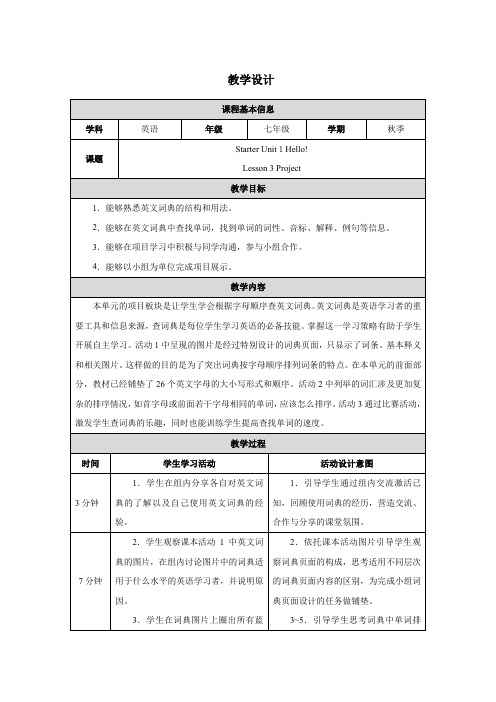
7.通过小组竞赛激发学生的学习热情,进一步掌握26个字母的顺序,练习查词典的学习技能。
8~9.引导学生通过设计本组的词典页面掌握词典页面的构成,巩固查词典的技能,整合语文、美术等学科的知识和技能进行初步的跨学科学习。同时引导学生积极参与小组学习,积极与组员沟通合作。
引导学生通过书面的方式进行项目学习反思及自我评价和反馈。
教学过程
时间
学生学习活动
活动设计意图
3分钟
1.学生在组内分享各自对英文词典的了解以及自己使用英文词典的经验。
1.引导学生通过组内交流激活已知,回顾使用词典的经历,营造交流、合作与分享的课堂氛围。
7分钟
2.学生观察课本活动1中英文词典的图片,在组内讨论图片中的词典适用于什么水平的英语学习者,并说明原因。
12分钟
10.各小组展示制作的词典页面,由一名组员进行简单讲解介绍页面构成,汇报成员分工和工作流程。
11.学生点评其他小组作品,并通过组员评价表为本组组员进行评价。
10.引导学生通过小组作品展示回顾合作的过程,并将关于词典的所学知识内化。
11.引导学生学会积极地对他人的工作进行客观评价。
作业
学生书面总结在本次项目式学习中的收获,或遇到的困难以及如何解决的。通过自评表进行自我评价。
教学内容
本单元的项目板块是让学生学会根据字母顺序查英文词典。英文词典是英语学习者的重要工具和信息来源,查词典是每位学生学习英语的必备技能。掌握这一学习策略有助于学生开展自主学习。活动1中呈现的图片是经过特别设计的词典页面,只显示了词条、基本释义和相关图片。这样做的目的是为了突出词典按字母顺序排列词条的特点。在本单元的前面部分,教材已经铺垫了26个英文字母的大小写形式和顺序。活动2中列举的词汇涉及更加复杂的排序情况,如首字母或前面若干字母相同的单词,应该怎么排序。活动3通过比赛活动,激发学生查词典的乐趣,同时也能训练学生提高查找单词的速度。
七年级英语上册《Starter Unit1 Good morning!》全单元教案 (新版)人教新目标版

Go for it! Book I Starter Unit 1 Good morning !单元目标与要求1.学习Aa --- Hh八个字母。
2.学习八个人名。
Alice, Bob, Cindy, Dale, Eric, Frank, Grace, Helen3.学习打招呼的用语:Hello!/ Good morning!/ Good afternoon!/ Good evening!4.学会问候熟识的朋友和应答:-- How are you?-- I’m fine, thanks. How are you?-- I’m OK.单元课时安排The 1st period:Section A 1a, 1b, 2a,The 2nd period:Section A 1a, 2b, 2c, 2d 3, 4aThe 3rd period:Section A 4b, 4c, Section B 1, 2a, 2bThe 4th period: Section B 3a, 3b, 4, 5The 5th period : SelfCheck and Just for Fun The first periodTeaching Contents and Analysis(教学内容与分析)Teaching materials(教学内容):Section A 1a, 1b, 2a,Teaching aims (教学目标)1.识别和掌握八个人名。
2.学会早上见面打招呼的用语。
3.正确认读Aa-Hh八个字母。
language points(语言点)1.词汇:Alice, Bob, Cindy, Dale, Eric, Frank, Grace, Helen2.句型:Hello! Good morning!Analysis of key items and difficulties of teaching(教学重点、难点分析):1、Important Points(重点): A--H八个字母教学,能认读,会书写。
新目标英语七年级上册新目标七年级英语上册starter全英教案
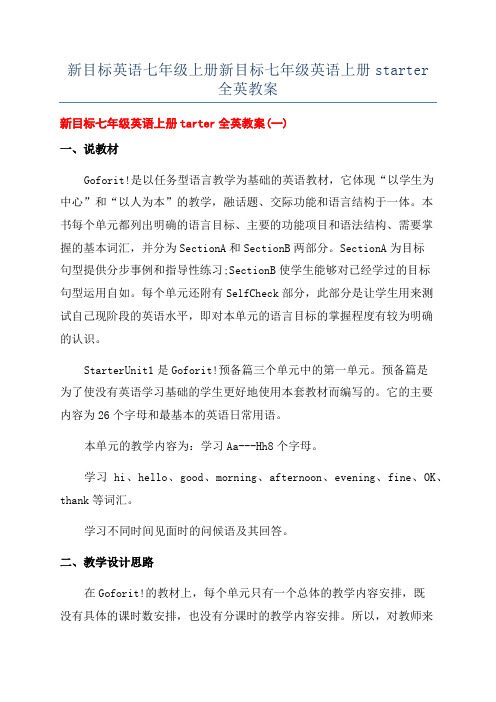
新目标英语七年级上册新目标七年级英语上册starter全英教案新目标七年级英语上册tarter全英教案(一)一、说教材Goforit!是以任务型语言教学为基础的英语教材,它体现“以学生为中心”和“以人为本”的教学,融话题、交际功能和语言结构于一体。
本书每个单元都列出明确的语言目标、主要的功能项目和语法结构、需要掌握的基本词汇,并分为SectionA和SectionB两部分。
SectionA为目标句型提供分步事例和指导性练习;SectionB使学生能够对已经学过的目标句型运用自如。
每个单元还附有SelfCheck部分,此部分是让学生用来测试自己现阶段的英语水平,即对本单元的语言目标的掌握程度有较为明确的认识。
StarterUnit1是Goforit!预备篇三个单元中的第一单元。
预备篇是为了使没有英语学习基础的学生更好地使用本套教材而编写的。
它的主要内容为26个字母和最基本的英语日常用语。
本单元的教学内容为:学习Aa---Hh8个字母。
学习hi、hello、good、morning、afternoon、evening、fine、OK、thank等词汇。
学习不同时间见面时的问候语及其回答。
二、教学设计思路在Goforit!的教材上,每个单元只有一个总体的教学内容安排,既没有具体的课时数安排,也没有分课时的教学内容安排。
所以,对教师来说,这是一个灵活运用教材的机会,任何教学内容的调整和取舍,都是合理的。
但这也是挑战,教师必须从所教学生的实际水平和语言能力出发,合理安排本单元的课时数,设计好每课时的教学内容。
所以,教师在教学设计时,首先因根据自己学生的实际水平和语言能力,排出整个单元的总课时数,然后安排好每个分课时的教学内容,设计好相应的教学步骤,以及运用相应的教学策略。
StarterUnit1的教学重点:Aa----Hh的字母教学相互问候:Goodmorning/afternoon/evening,Alice!Hello,Frank!Hi,Cindy!HowareyouI’mfine/OK,thank.教学难点:a)不同时间的不同问候;b)人名的读法和人物与名字的配对(8个)。
- 1、下载文档前请自行甄别文档内容的完整性,平台不提供额外的编辑、内容补充、找答案等附加服务。
- 2、"仅部分预览"的文档,不可在线预览部分如存在完整性等问题,可反馈申请退款(可完整预览的文档不适用该条件!)。
- 3、如文档侵犯您的权益,请联系客服反馈,我们会尽快为您处理(人工客服工作时间:9:00-18:30)。
Starter教案1. Good morning/afternoon/evening. 早上(上午)/下午/晚上好。
答语相同。
在熟人或家人之间可省略good。
熟人之间的问候可加上称呼语,称呼语放在问候语之后且用逗号隔开。
如:Good morning , class!同学们,早上好!△Good night!晚安(晚间告别用语)2. Hello, Frank! 你好,弗兰克。
3. A: How are you? 你(身体)好吗?B: (I’m) fine/Very well/I’m OK, Th ank you./thanks. How are you? / And you? 我很好,谢谢。
你呢?A: (I’m)fine/OK, t oo. 我也很好。
4. thanks = thank you 谢谢5. HB(铅笔芯)硬黑 CD光盘 BBC英国广播公司Starter Unit 2 What’s this in English?1.What’s this/that? 这/那是什么?It’s a/an + 单数物品(△不说This/That is...)1) What’s this/that? 这/那是什么?2) What’s this/that? 这/那是什么?It’s a ruler. (这/那是)直尺。
It’s an apple. (这/那是)苹果。
2.What’s this/that in English? 这/那用英语怎么说?It’s a/an + 单数物品(△不说This/That is...)What’s this in Engl ish? 这用英语怎么说?It’s a jacket. 夹克衫What’s that in English? 那用英语怎么说?It’s an orange. 橘子。
in + 语言:用某种语言 in Chinese/English/Japanese用汉/英/日语英语中还可用What’s the English for….?表达同样的含义。
What’s the English for直尺?直尺用英语怎么说?It’s a ruler.是ruler3.a 和an是不定冠词,只用在可数名词单数前面,表示“一”。
a用在以辅音音素开头的单词前;an用在以元音音素开头的单词前。
这里的元音音素和辅音音素是指读音,而不是指字母。
如:a pen /pen/ 一支钢笔 (/p/为辅音音素)an orange /’ ɒrindʒ / 一个桔子 (/ɒ /为元音音素)4. P停车场;停车位 NBA(美国)全国篮球协会 kg千克;公斤5. Spell it, please. = Pl ease spell it. 请拼读它。
K – E - Y.Spell “pen”, please. = Please spell pen. 请拼读“pen”。
P – E - N.注:please置于句末时,前面要加逗号。
Starter Unit 3 What color is it?1.What’s this/that? 这/那是什么?It’s V. 这是V。
V是字母,是专有名词,前面不必加冠词,但表示某一类东西,则在其单数名词前加a或an。
1) What’s this/tha t? 这/那是什么?2) What’s this/that? 这/那是什么?It’s a ruler. (这/那是)直尺。
It’s an apple. (这/那是)苹果。
2.问颜色:What color1) What color is + 单数名词? 2) What color are + 复数名词?It’s /It is + 颜色. They’re/They are + 颜色.如1) What color is the key?(这把)钥匙是什么颜色的?It’s (It is)yellow. (它是)黄色的。
2) What color are the keys? 这些钥匙是什么颜色的?They’re (They are) red.. (它们)是红色的。
3. color 1) n.颜色 2) v. 给......着色,把......染成某种颜色 color sth + 颜色:把某物涂成……颜色 Color the pencil red. 把铅笔涂成红色。
4.It’s black and white. 它是黑白色的。
5.S 小号的 M 中号的 L 大号的 UFO 不明飞行物 CCTV 中国中央电视台 UN 联合国6. The key is yellow. 钥匙是黄色的。
The是定冠词,表示“这(个),那(个),这些,那些” ,在元音音素前读/ ði: /,在辅音音素前读/ð ə /。
它可以用在名词前,表示特指说话双方都知道的人或物,或上文提到的人或物。
1) The book on the desk is mine. 桌子上的书是我的。
(特指)2) Where is the teacher? 老师在哪?(双方都知道)3) He has a pen, the pen is black. 他有支钢笔,钢笔是黑色的。
(指上文提到的事物)7. 七年级字母教学资料1)英语中共有26个字母。
其中的Aa,Ee,Ii,Oo,Uu 5个字母被称为元音字母。
这五个元音字母是构成英语成千上万单词的核心,除了一些缩略词之外,其它任何一个英语单词,通常都应包含一个或多个元音字母。
26个字母中的其它21个字母被称为辅音字母。
2)字母书写的规格①斜度:每个字母都要稍向右斜约10°左右,斜度要一致。
②大写字母的书写规格是:上不顶天下立地。
即笔画的上端稍离第一线,笔画的下端必须紧贴第三线,不许离线也不许出格。
③占中间格的小写字母有a, c, e, m, n, o, r, s, u, v, w, x, z 13个,它们笔画的上端必须紧贴第二线,下端必须紧贴第三线,不许离线也不许出格。
④占一格、二格的小写字母有b, d, h, k, l共5个,它们笔画的上端必须顶第一线,下端必须顶第三线,不许离线也不许出格。
⑤小写字母i和t也占一格、二格。
但t的上端在第一格中间,短横重合第二线;i的小圆点在第一格中间稍偏下处。
⑥占二格、三格的小写字母有g, q, y 3个,它们的笔画的顶端要紧贴第二线,下端要紧贴第四线,不可离线也不可出格。
⑦占一格、二格、三格的小写字母有f, j, p 3个。
其中f的上端稍离第一线(和大写字母一样),下端紧贴第四线,短横重合第二线;j的小圆点与i的小圆点位置相同,下面一笔的上端顶第二线,下端紧贴第四线;p的上端略高于第二线,约占第一格的三分之一,下端紧贴第四线。
⑧字母按所含音素归类表:/ei / 字母: Aa Hh Jj Kk音标: /ei / /e t∫ / /dʒe / /ke//i:/ 字母: Bb Cc Dd Ee Gg Pp Tt V音标: /bi:/ /si:/ /di:/ /i:/ /dʒi:/ /pi:/ /ti:/ /vi:/ /ɑi/ 字母: Ii Yy音标: /ɑ / /wɑ // əʊ / Oo /əʊ // ju: / 字母: Uu Qq Ww音标: /ju:/ /kju:/ /`dΛblju://ɑ: / Rr /ɑ: //e/ 字母: Ff Ll Mm Nn Ss Xx Zz音标: /ef/ /el/ /em/ /en/ /es/ /eks/ /zed/8.缩写词: HK香港 ID身份 PE体育课 PRC 中华人民共和国 RMB 人民币 PLA中国人民解放军 CCP中国共产党 IOC国际奥林匹克委员会 am 上午 pm下午 cm厘米mm毫米9.英语句子的书写句子开头的第一个单词的第一个字母要大写,单词与单词之间要有适当的距离,一般为放入一个字母的空隙,句末要有标点符号,英语的句号是个实心圆点,而不是汉语中的小圆圈。
10..大写字母的用法1)英语句子开头的第一个字母必须大写。
2)I(我),OK在句中任何位置都大写。
3)人名、地名、国名、某国人或某种语言等专有名词的第一个字母必须大写。
4)电影名、书名、报刊、文章的标题等中的每个实词(如:名词、动词、形容词、副词、数词)的第一个字母一般大写。
English Weekly《英语周报》Titanic《泰坦尼克号》 5)表示月份、星期、重要节日的名词的第一个字母必须大写。
6)某些缩略词的第一个字母都必须大写。
7)表示称呼的名词的第一个字母通常要大写。
Uncle Wang王叔叔11.词类12.英语句子成分:组成句子的各个部分即句子成分。
句子成分包括:主语、谓语、宾语、表语、定语、状语、补足语等。
一、主语(subject): 句子说明的人或事物。
1.The sun rises in the east.太阳从东方升起。
(名词)2.He likes dancing.他喜欢跳舞。
(代词)3.Twenty years is a short time in history. 二十年在历史中是个很短的时间。
(数词)4.Seeing is believing.眼见为实。
(动名词)5.To see is to believe. 眼见为实。
(不定式)6.What he needs is a book. 他所需要的是本书(主语从句)二、谓语(predicate): 说明主语的动作、状态和特征。
1.We study English. 我们学习英语2. He is asleep. 他睡着了。
三、表语(predicative):表示主语“是什么”或者“怎么样”,表语前面的动词称为系动词。
1. He is a teacher.他是个老师(名词2. Five and five is ten.五加五等于十(数词)3.He is asleep.他睡着了(形容词)4.His father is in. 他的父亲在家(副词)5.The picture is on the wall.画在墙上。
(介词短语)6.That sounds good 那听起来很好。
7.Tom looks thin. 汤姆看上去很瘦。
常见的系动词有: be, sound(听起来), look(看起来), feel(摸起来,smell(闻起来), taste(尝起来、吃起来), feel(感觉) ...四、宾语:动作、行为的对象1.I like China.我喜欢中国。
(名词)2.You can help me. 你能帮助我。
(代词)3.How many do you need? We need two. 你们需要多少?我们需要两个。
(数词)4. I like playing soccer. 我喜欢踢足球。
